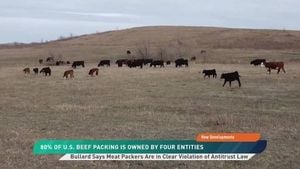As California barrels toward its November 4, 2025, special election, the Golden State finds itself at the center of a political maelstrom with national consequences. The only measure on the ballot—Proposition 50—has ignited fierce debate over the state’s congressional redistricting process, pitting Governor Gavin Newsom and his allies against a coalition of Republicans, rural residents, and some local officials who warn of dire consequences for representative democracy.
Proposition 50, if approved, would temporarily suspend California’s nonpartisan citizen redistricting commission and redraw the state’s congressional districts to favor Democrats for the next three election cycles. According to CalMatters, the measure could flip the partisan advantage of five GOP-held House seats and pull more Democrats into five other swing districts. The result? California’s 52-member congressional delegation could be left with as few as four Republicans—a seismic shift in the nation’s most populous state.
The origins of Proposition 50 are rooted in a broader national struggle over redistricting. Over the summer, President Donald Trump pressured Texas Republicans to call a special session and redraw their state’s congressional lines, eliminating five Democratic-held seats. With other conservative states poised to follow suit, Newsom responded with his own gambit, pledging to offset those Republican gains by reshaping California’s districts in Democrats’ favor. But unlike most states, where legislators control the map, California’s independent commission—created by voters—means Newsom needs direct voter approval for his plan.
“We have to fight fire with fire,” Newsom has argued, making the case that aggressive gerrymandering is the only way to give Democrats a shot at reclaiming the House and countering what he describes as Trump’s “authoritarian policies.” His advocacy has fired up Democratic activists and made him a hero among progressives, but it’s also drawn the ire of Republicans and some nonpartisan groups who see the measure as a dangerous precedent.
In Kern County, the local Board of Supervisors voted 4-to-1 on September 23 to formally oppose the proposition. District One Supervisor Philip Peters, who introduced the opposition measure earlier in the month, didn’t mince words, calling Proposition 50 “a textbook definition of unfree and unfair elections,” as reported by KBAK/KBFX. Supervisor Leticia Perez was the lone dissenting vote, but the board’s opposition underscores the deep divisions the measure has sparked across the state.
The concerns are especially acute in rural communities like Modoc County, where the proposed map would group this high-desert, agriculture-driven area with Marin County in the Bay Area—a region with vastly different priorities. Modoc County supervisors have declared their opposition to Proposition 50, fearing that their agricultural interests and perspectives on water, wildlife, and forest management will be drowned out by urban, environmentally focused voters. “It’s a death knell for rural representation,” one local official lamented, according to Sierra News Online. Modoc’s history of resistance to Sacramento’s liberal policies is well known—the county even flirted with secession in 2013 as part of the “State of Jefferson” movement.
Meanwhile, the political stakes extend far beyond California’s borders. As CalMatters notes, the fight over Proposition 50 is seen as a proxy battle for control of the U.S. House of Representatives. Trump’s Republican majority in Congress is razor-thin—a mere five seats, the smallest in decades. Losing just a handful of California districts could upend his policy agenda and open the door to congressional investigations. For Newsom, success could bolster his national profile ahead of a possible 2028 presidential run. For Republicans, defeating the measure is nothing less than a fight for survival in the state—and perhaps a blow to Newsom’s ambitions.
Supporters of Proposition 50 say it’s a necessary countermeasure to Republican gerrymandering elsewhere. They point to the Trump administration’s targeting of immigrants, erosion of democratic norms, and a federal budget that could slash $28 billion from California’s health care over the next decade. “We’re not going to stand by while other states rig the system,” one Democratic strategist told Sierra News Online. The governor’s office has even branded the measure the “Election Rigging Response Act.”
Opponents, however, see the plan as a naked power grab, undermining the very principles of fair representation that California’s independent commission was designed to protect. “Defeating the measure would not only save the GOP from political annihilation in the state but could also weaken Newsom ahead of an expected run for president in 2028,” CalMatters observed. Rural residents, in particular, worry that their voices will be lost in the shuffle, their interests subordinated to the priorities of urban and suburban voters.
The impact of Proposition 50 would vary across the state. In some districts, the changes are minimal—a decrease in registered Democrats from 31% to 29% and an increase in registered Republicans from 43% to 44%, according to Sierra News Online. But in others, the shifts are dramatic. For example, the 8th congressional district, which includes Richmond and is represented by Democrat John Garamendi, would see its Democratic registration drop from 58% to 52%, while Republican registration would jump from 14% to 19%, CalMatters reports.
The campaign has already attracted over $90 million in spending, and two recent polls suggest Californians are leaning toward approval—though many remain undecided. The debate has spilled into the public square, with lawn signs, heated town halls, and a barrage of advertisements on both sides. As one observer quipped, “All eyes are on California this fall.”
For voters, the process is straightforward but crucial. Every registered voter will receive a mail-in ballot, with counties beginning to mail them on October 6. The last day to register online is October 20, and some polling places will open for early in-person voting on October 25. The deadline to request a vote-by-mail ballot is October 28, and the special election itself is set for November 4. State officials urge voters to mail their ballots as soon as possible to ensure they’re counted promptly. Information on voting locations and procedures is readily available through the Secretary of State’s website, by texting “VOTE” to GOVOTE (468-8683), or by calling the state’s voter hotline.
No matter the outcome, Proposition 50 is poised to reshape not just California’s political landscape but the balance of power in Washington. As the nation watches, the state’s voters face a stark choice: uphold the tradition of independent redistricting, or embrace a hard-edged, partisan response in a rapidly escalating national arms race over democracy itself.




